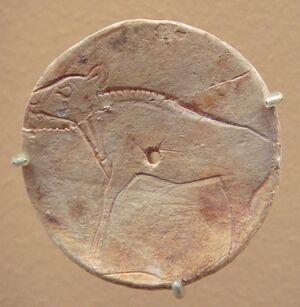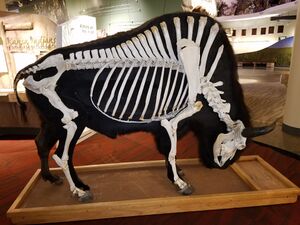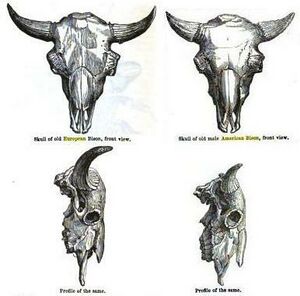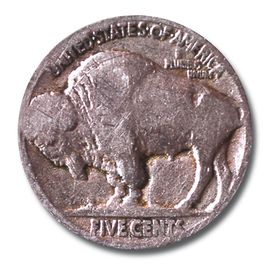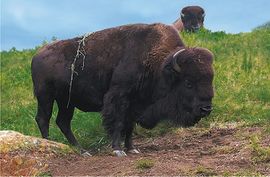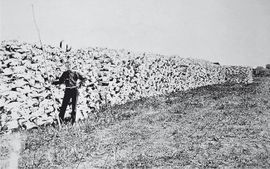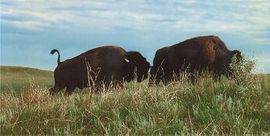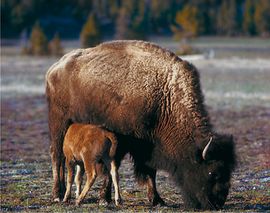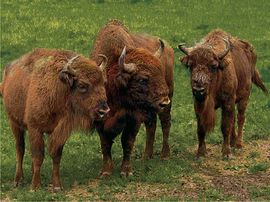بايسون
| بايسون | |
|---|---|
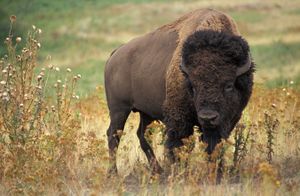
| |
| American bison (Bison bison) | |
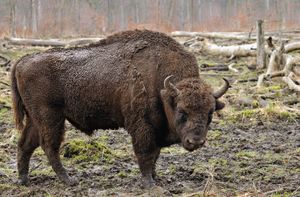
| |
| European bison (Bison bonasus) | |
| التصنيف العلمي | |
| أصنوفة غير معروفة (أصلحها): | Bison |
| Type species | |
| Bison bison | |
| Species | |
| |

| |
| IUCN range of the two American bison subspecies.
Plains bison (Bison bison subsp. bison) Wood bison (Bison bison subsp. athabascae) | |

| |
| IUCN range of the European bison.
European bison (Bison bonasus) | |
بايسون أو البيزون Bison حيوان من الفصيلة البقرية family Bovidae يتميز بحجمه الكبير، ولا سيما الجزء الأمامي منه. عاش منذ العصور الجليدية في أوروبا وأمريكا وكندا بأعداد بلغت الملايين، وقد أدت ماشيته دوراً مهماً في حياة الشعوب الهندية قبل مجيء المهاجرين البيض إلى أمريكا، والذين قاموا بصيدها بلا هوادة حتى كادت تنقرض في القرن التاسع عشر، وتعيش اليوم أعداد قليلة منها في المحميات والمتنزهات الوطنية في الولايات المتحدة وكندا وأوروبا.
البيسون هو is a large bovine in the genus Bison (Greek: "wild ox" (bison)[1]) within the tribe Bovini. Two extant and numerous extinct species are recognised.
Of the two surviving species, the American bison, B. bison, found only in North America, is the more numerous. Although colloquially referred to as a buffalo in the United States and Canada,[2] it is only distantly related to the true buffalo. The North American species is composed of two subspecies, the Plains bison, B. b. bison, and the wood bison, B. b. athabascae, which is the namesake of Wood Buffalo National Park in Canada. A third subspecies, the eastern bison (B. b. pennsylvanicus) is no longer considered a valid taxon, being a junior synonym of B. b. bison.[3] References to "woods bison" or "wood bison" from the eastern United States refer to this subspecies, not B. b. athabascae, which was not found in the region. The European bison, B. bonasus, or wisent, or zubr, or colloquially European buffalo, is found in Europe and the Caucasus, reintroduced after being extinct in the wild.
While bison species have been traditionally classified in their own genus, modern genetics indicates that they are nested within the genus Bos, which includes, among others, cattle, yaks and gaur, being most closely related to yaks. Bison are sometimes bred with domestic cattle and produce offspring called beefalo or zubron.
. . . . . . . . . . . . . . . . . . . . . . . . . . . . . . . . . . . . . . . . . . . . . . . . . . . . . . . . . . . . . . . . . . . . . . . . . . . . . . . . . . . . . . . . . . . . . . . . . . . . . . . . . . . . . . . . . . . . . . . . . . . . . . . . . . . . . . . . . . . . . . . . . . . . . . . . . . . . . . . . . . . . . . . .
التصنيف الحيواني
للبايسون نوعان: البايسون الأمريكي والبايسون الأوروبي، ويبين الجدول رقم (1) موقعهما في التصنيف الحيواني، وبعض المواصفات الخاصة بهما.
الوصف
The American bison and the European bison (wisent) are the largest surviving terrestrial animals in North America and Europe. They are typical artiodactyl (cloven hooved) ungulates, and are similar in appearance to other bovines such as cattle and true buffalo. They are broad and muscular with shaggy coats of long hair. Adults grow up to 2 metres (6 feet 7 inches) in height and 3.5 m (11 ft 6 in) in length for American bison[4][5] and up to 2.1 m (6 ft 11 in) in height[6] and 2.9 m (9 ft 6 in) in length for European bison.[7] American bison can weigh from around 400 to 1,270 kilograms (880 to 2,800 pounds)[5][8] and European bison can weigh from 800 to 1,000 kg (1,800 to 2,200 lb).[7] European bison tend to be taller than American bison.
Bison are nomadic grazers and travel in herds. The bulls leave the herds of females at two or three years of age, and join a herd of males, which are generally smaller than female herds. Mature bulls rarely travel alone. Towards the end of the summer, for the reproductive season, the sexes necessarily commingle.[9]
American bison are known for living in the Great Plains, but formerly had a much larger range, including much of the eastern United States and parts of Mexico. Both species were hunted close to extinction during the 19th and 20th centuries, but have since rebounded. The wisent in part owes its survival to the Chernobyl disaster, as the Chernobyl Exclusion Zone has become a kind of wildlife preserve for wisent and other rare megafauna such as the Przewalski's horse, though poaching has become a threat in recent years.[10] The American Plains bison is no longer listed as endangered, but this does not mean the species is secure. Genetically pure B. b. bison currently number only about 20,000, separated into fragmented herds—all of which require active conservation measures.[11] The wood bison is on the endangered species list in Canada[12] and is listed as threatened in the United States, though numerous attempts have been made by beefalo ranchers to have it entirely removed from the Endangered Species List.[13]
Although superficially similar, physical and behavioural differences exist between the American and European bison. The American species has 15 ribs, while the European bison has 14. The American bison has four lumbar vertebrae, while the European has five.[14] (The difference in this case is that what would be the first lumbar vertebra has ribs attached to it in American bison and is thus counted as the 15th thoracic vertebra, compared to 14 thoracic vertebrae in wisent.) Adult American bison are less slim in build and have shorter legs.[15] American bison tend to graze more, and browse less than their European relatives. Their anatomies reflect this behavioural difference; the American bison's head hangs lower than the European's. The body of the American bison is typically hairier, though its tail has less hair than that of the European bison. The horns of the European bison point through the plane of their faces, making them more adept at fighting through the interlocking of horns in the same manner as domestic cattle, unlike the American bison, which favours butting.[16] American bison are more easily tamed than their European cousins, and breed with domestic cattle more readily.[17]
التطور والتاريخ الجيني
The bovine tribe (Bovini) split about 5 to 10 million years ago into the buffalos (Bubalus and Syncerus) and a group leading to bison and taurine cattle.[18] Genetic evidence from nuclear DNA indicates that the closest living relatives of bison are yaks, with bison being nested within the genus Bos, rendering Bos without including bison paraphyletic. While nuclear DNA indicates that both extant bison species are each others closest living relatives, the mitochondrial DNA of European bison is more closely related to that of domestic cattle and aurochs (while the mitochondrial DNA of American bison is closely related to that of yaks). This discrepancy is either suggested to be the result of incomplete lineage sorting or ancient introgression.[19][20][21] Bison are widely believed to have evolved from a lineage belonging to the extinct genus Leptobos during the Late Pliocene to Early Pleistocene in Asia. The earliest members of the bison lineage, known from the Late Pliocene to Early Pleistocene of the Indian Subcontinent (Bison sivalensis) and China (Bison palaeosinensis), approximately 3.4-2.6 million years ago (Ma) are placed in the subgenus Bison (Eobison). The oldest remains of Eobison in Europe are those Bison georgicus found in Dmanisi, Georgia, dated to around 1.76 Ma. More derived members of the genus are placed in the subgenus Bison (Bison), which first appeared towards the end of the Early Pleistocene, around 1.2 Ma, with early members of the subgenus including the widespread Bison schoetensacki.[22]
The steppe bison (Bison priscus) first appeared during the mid-Middle Pleistocene in eastern Eurasia, and subsequently became widely distributed across Eurasia.[22] During the late Middle Pleistocene, around 195,000-135,000 years ago, the steppe bison migrated across the Bering land bridge into North America, becoming ancestral to modern American bison, as well as extinct forms such as the largest known bison, the long-horned Bison latifrons, and the smaller Bison antiquus, which became extinct at the end of the Late Pleistocene.[23] Modern American bison are thought to have evolved from B. antiquus during the Late Pleistocene-Holocene transition via the intermediate form Bison occidentalis.[24] The European bison, Bison bonasus, first appeared in Europe during the late Middle Pleistocene, where it existed in sympatry with the steppe bison. Its relationship with other extinct bison species is unclear, though it appears to be only distantly related to the steppe and American bisons, with possibly some interbreeding between the two lineages during the Middle Pleistocene.[20] The steppe bison survived into the early-mid Holocene in Alaska-Yukon and eastern Siberia, before becoming extinct.[25][26]
During the population bottleneck caused by the great slaughter of American bison during the 19th century, the number of bison remaining alive in North America declined to as low as 541. During that period, a handful of ranchers gathered remnants of the existing herds to save the species from extinction. These ranchers bred some of the bison with cattle in an effort to produce "cattleo"[27] (today called "beefalo") Accidental crossings were also known to occur. Generally, male domestic bulls were crossed with bison cows, producing offspring of which only the females were fertile. The crossbred animals did not demonstrate any form of hybrid vigor, so the practice was abandoned. Wisent-American bison hybrids were briefly experimented with in Germany (and found to be fully fertile) and a herd of such animals is maintained in Russia. A herd of cattle-wisent crossbreeds (zubron) is maintained in Poland. First-generation crosses do not occur naturally, requiring caesarean delivery. First-generation males are infertile. The U.S. National Bison Association has adopted a code of ethics that prohibits its members from deliberately crossbreeding bison with any other species. In the United States, many ranchers are now using DNA testing to cull the residual cattle genetics from their bison herds. The proportion of cattle DNA that has been measured in introgressed individuals and bison herds today is typically quite low, ranging from 0.56 to 1.8%.[27][28]
There are also remnant purebred American bison herds on public lands in North America. Herds of importance are found in Yellowstone National Park, Wind Cave National Park in South Dakota, Blue Mounds State Park in Minnesota, Elk Island National Park in Alberta, and Grasslands National Park in Saskatchewan. In 2015, a purebred herd of 350 individuals was identified on public lands in the Henry Mountains of southern Utah via genetic testing of mitochondrial and nuclear DNA.[29] This study, published in 2015, also showed the Henry Mountains bison herd to be free of brucellosis, a bacterial disease that was imported with non-native domestic cattle to North America.[30]
In 2021, the American Society of Mammalogists considered Bison to be a subgenus, and placed both bison species back into Bos.[31][المصدر لا يؤكد ذلك]
الجدول (1)
| *** | البيزون الأمريكي | متغير3 |
|---|---|---|
| الشعبة | الفقاريات | الفقاريات |
| الصف | الثدييات | الثدييات |
| الرتبة | زوجية الحوافر | زوجية الحوافر |
| الفصيلة | البقرية | البقرية |
| الجنس | Bison bison | Bison bonasus |
| مدة الحمل (يوم) | 260-280 | 287 |
| عدد المواليد | 1 | 1 |
| إرتفاع الغارب (متر) | 1.6-1.8 | 1.8- 2.0 |
| طول الجسم (متر) | 2.1- 3.5 | 2.7 |
| طول الذيل (سم) | 50-60 | 80 |
| فترة الرضاعة (شهر) | حتى 12 | حتى 6 |
البايسون الأمريكي
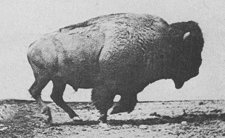
يعدّ البايسون الأمريكي (الشكلان 1 و2) من أكبر الثدييات في الولايات المتحدة الأمريكية، ويصل وزن ثيرانه إلى نحو 1800 كغ، وأبقاره إلى نحو نصف ذلك، الجزء الأمامي من جسمه عريض، وهو كبير الحجم رأسه ضخم مقارنة مع جسمه، وهو أكثر ضخامة وأقل ارتفاعاً من البايسون الأوربي، له قرنان قويان وقصيران يخرجان من الجمجمة باتجاه الأعلى مع انحناء خفيف وتستعملان سلاحاً في القتال، وللحيوان ألوان عدة تراوح من الأبيض إلى الرمادي، والأحمر أو المرقط.
ينمو شعره كثيفاً، ولاسيما على الجزء الأمامي من الجسم، ويصل طوله على الرأس والعنق والأكتاف ومقدمة الأرجل إلى نحو 50 سم، كما يشكل الشعر على الجبهة مابين القرنين غطاءً سميكاً حتى الأنف. ويطلق الأمريكيون عليه اسم الجاموس buffalo. وهو يعيش أساساً في السهول، وكذلك في مناطق مرتفعة في بعض الولايات.
اعتمد هنود أمريكا الشمالية في مناطق السهول على صيد البايسون لتلبية احتياجاتهم من الغذاء والملبس، وإنشاء خيامهم البسيطة، وكانوا يقدسونه في طقوس الصيد الدينية، ويصيدونه من دون إفراط.
وفي عام 1700 كان يعيش نحو 60 مليون رأس من البايسون، تتجول ضمن قطعان كبيرة من شمالي أمريكا إلى [ألاسكا] وعبر منحدرات جبال روكي الممتدة حتى المكسيك، وعبر القارة وصولاً إلى المحيط الأطلسي.
في عام 1830 بدأت عمليات منظّمة لإبادة البايسون في أمريكا، في أثناء إنشاء خطوط السكك الحديدية في القارة الأمريكية. وفي عام 1865 بدأت المرحلة النهائية لعملية الإبادة الجماعية الوحشية لهذا الحيوان، إذ ذُبحت آلاف عديدة منه لتزويد عمال السكك الحديدية باللحم، كما انتشرت في هذا الوقت رياضة مثيرة للاشمئزاز هي رياضة إطلاق النار على قطعان البايسون، التي كانت تتجول في البراري المجاورة لخطوط السكك الحديدية، إذ كان يُسمح للمسافرين بقتل العديد منها للمتعة عبر نوافذ القطارات، وكان يؤخذ من الحيوانات المقتولة ألسنتها فقط لاستخدامها طعاماً شهياً أو للحصول على جلودها، وتترك جثثها وجماجمها لتتعفن ملقاة بعد سلخ جلودها على مساحات واسعة من الأرض (الشكل 3)، كما كانت تنظم حملات جماعية لقتل هذا الحيوان والقضاء على مصدر أساسي لغذاء الهنود الحمر.
وفي المدة الممتدة بين عامي 1871- 1884 قضي على غالبية حيوانات البايسون في الشمال الأمريكي، وبحلول عام 1889 بقي فقط 550 حيواناً من البايسون على قيد الحياة في أمريكا.
وفي عام 1907 نظّمت الحكومة الأمريكية حملة للمحافظة على البايسون في حديقة حيوان أوكلاهوما تضمنت قطيعاً مكوناً من 15 رأساً، وكذلك في ولايات مونتانا ونبراسكا وداكوتا وغيرها. كما بذلت جهود مماثلة في كندا، فازدادت أعداده في أمريكا وكندا إلى نحو 5000 رأس فقط عام 1920، وتطورت رعايته فيما بعد لتصل إلى /30/ ألف رأس.
. . . . . . . . . . . . . . . . . . . . . . . . . . . . . . . . . . . . . . . . . . . . . . . . . . . . . . . . . . . . . . . . . . . . . . . . . . . . . . . . . . . . . . . . . . . . . . . . . . . . . . . . . . . . . . . . . . . . . . . . . . . . . . . . . . . . . . . . . . . . . . . . . . . . . . . . . . . . . . . . . . . . . . . .
عاداته
يتغذى البايسون غالباً بالأعشاب والمراعي والأوراق والبراعم والأغصان ولحاء الأشجار والشجيرات، وكانت حيواناته تهاجر في فترة الحمل مسافة تراوح بين 350 و650 كم جنوباً لقضاء الشتاء على أراضي المراعي الجيدة. وفي الربيع كانت تعود إلى الشمال، وتمضي معظم وقتها في رعي الأعشاب والمراعي، ويمكن أن يلتهم الحيوان نحو 1.6 % من وزنه علفاً جافاً في اليوم ويحتاج إلى الماء يومياً.
يصدر البايسون أصواتاً عميقة ومكتومة يمكن أن تسمع عندما تتحرك القطعان. وفي موسم التزاوج، تطلق ثيرانه أصواتاً هادرة مزمجرة يمكن سماعها عبر مسافات بعيدة، وكذلك عندما تكون في حالة غضب وقتال، ويستطيع الحيوان رؤية أشياء كبيرة من بعد يصل إلى كيلومتر.
والبايسون حيوان خطر يهجم بسرعة عندما يكون في وضع حرج وخطر وقريباً من أعدائه. حاسة شمه متطورة جداً، ولديه حاسة سمع جيدة. كما يقوم بفرك رأسه وعنقه وجوانب جسمه بالأشجار والأغصان والجذوع أو الصخور للتخلص من الشعر الشتوي الميت، ويحب التمرغ في الرمال الرخوة والطين لتبريد جسمه وإبعاد الحشرات عنه، ويستطيع الركض بسرعة.
يعيش البايسون البري 15-20 سنة، ويتوقف هذا العمر على عدة عوامل من أهمها تعرضه للصيد. وقد عاشت بعض أفراده في الأسر حتى 40 سنة.
تعيش إناث البايسون مع صغارها ضمن قطعان تقودها البقرة الأكبر سناً، أما الذكور فتعيش منعزلة عن الإناث ضمن قطعان ومجموعات، وتلتحق بالإناث عند موسم التزاوج.
يمتد موسم تزاوجه بين أيار/مايو وأيلول/سبتمبر، حيث تلتقي مجموعات من الثيران والأبقار ضمن مجموعات قطعان كبيرة، وتشكل الثيران صفوفاً من المجموعات التي تتقاتل فيما بينها وغالباً ما تنتهي بجروح خطيرة، وأحياناً بموت أحد الخصوم.
- يدل ذيل البايسون على حالته النفسية فإذا كان ذيله طليقاً فيعني أنه مرتاح، وإذا رفعه قليلاً فيعني أنه يقظ، وإذا كان أفقياً فيعني أنه متحمس، أما إذا رفعه عمودياً فيشير إلى أنه جاهز للقتال (الشكل 4).
يبلغ طول دورة الشبق (الشياع) نحو ثلاثة أسابيع، وفترة الشبق نحو 9- 28 ساعة، وتلد الأبقار مواليدها بعد نحو تسعة أشهر من الحمل، ويكون المولود مكسواً بغطاء أحمر أو رمادي وترضع المواليد من أماتها مدة 7- 8 أشهر، وتصبح بالغة في عمر سنتين إلى ثلاث سنوات من عمرها (الشكل 5). وتقوم الأمات برعاية المواليد والدفاع عنها، في حين لا تهتم الذكور بذلك.
البايسون الأوربي bison bonasus (الشكل 6) أصغر حجماً من الأمريكي ويبلغ وزن الأنثى نحو 300 -500 كغ والذكر نحو 400- 920 كغ، وللمجموعتين الألوان نفسها تقريباً. ويكون موسم التزاوج بين شهري آب /أغسطس وتشرين الأول/أكتوبر، وتقع معظم الولادات في شهري أيار /مايو إلى تموز/يوليو. وتبلغ الذكور والإناث جنسياً في عمر 3-4 سنوات. وتستمر الإناث بالولادة حتى عمر 21 سنة، وتمتد حياتها حتى 27 سنة، مدة حملها نحو ثمانية أشهر ويزن مولودها نحو 40كغ. يرضع من أمه نحو ستة أشهر ويبدأ بتناول الأعلاف معها وعمره نحو ثلاثة أسابيع.
قام العديد من الدول الأوربية برعاية وإكثار الأعداد المتبقية من البايسون في حدائق الحيوان، ولاسيما في حديقة حيوان برلين، وكذلك في حدائق أمستردام وبودابست وڤيينا وغيرها. وقد بلغ عدد البايسون الأوربي عام 1967 نحو860 رأساً.
معرض الصور
Legendary albino buffalo statue at the Scurry County courthouse in Snyder, Texas
Dried buffalo meat at Finney County Historical Museum in Garden City, Kansas
Herd of bison grazing in Elk Island National Park, Alberta, Canada
An American Bison standing its ground against a gray wolf pack
A small group of bison at Antelope Island State Park surrounded by the Great Salt Lake in Utah
Bison fighting in Grand Teton National Park, Moose, Wyoming
المصادر
انظر أيضاً
الهامش
- ^ "Glossary. American Museum of Natural History". Archived from the original on 20 November 2021.
- ^ Olson, Wes. "Bison". The Canadian Encyclopedia. Archived from the original on 17 March 2014. Retrieved 2013-04-23.
- ^ "BIson americanus pennsylvanicus". ITIS. Archived from the original on 14 March 2017. Retrieved 13 March 2017.
- ^ Gennady G. Boeskorov, Olga R. Potapova, Albert V. Protopopov, Valery V. Plotnikov, Larry D. Agenbroad, Konstantin S. Kirikov, Innokenty S. Pavlov, Marina V. Shchelchkova, Innocenty N. Belolyubskii, Mikhail D. Tomshin, Rafal Kowalczyk, Sergey P. Davydov, Stanislav D. Kolesov, Alexey N. Tikhonov, Johannes van der Plicht, 2016, The Yukagir Bison: The exterior morphology of a complete frozen mummy of the extinct steppe bison, Bison priscus from the early Holocene of northern Yakutia, Russia, pp.7, Quaternary International, Vol.406 (25 June 2016), Part B, pp.94-110
- ^ أ ب [1] "American Bison", The National Wildlife Federation.
- ^ Semenov U.A. of WWF-Russia, 2014, "The Wisents of Karachay-Cherkessia", Proceedings of the Sochi National Park (8), pp.23-24, ISBN 978-5-87317-984-8, KMK Scientific Press
- ^ أ ب Hendricks, K. "Bison bonasus, European bison", Animal Diversity Web, 2013.
- ^ Joel Berger; Carol Cunningham (June 1994). Bison: mating and conservation in small populations. Columbia University Press. p. 162. ISBN 978-0-231-08456-7.
- ^ Brink, Jack W. (2008). Imagining Head-Smashed-In: Aboriginal Buffalo Hunting on the Northern Plains (PDF). Athabasca University Press. ISBN 978-1-897425-09-1. Archived (PDF) from the original on 16 December 2011.
- ^ "Chernobyl's Przewalski's horses are poached for meat". BBC. Archived from the original on 31 December 2016. Retrieved 13 March 2017.
- ^ "Bison bison". IUCN Red List of Threatened Species. Archived from the original on 7 April 2017. Retrieved 13 March 2017.
- ^ "U.S. Fish and Wildlife Service Species Report". Archived from the original on 19 October 2011. Retrieved 2009-06-03.
- ^ "Wood Bison". U.S. Fish & Wildlife Service ECOS Environmental Conservation Online System. Archived from the original on 14 March 2017. Retrieved 13 March 2017.
- ^ The Penny Cyclopædia of the Society for the Diffusion of Useful Knowledge by Society for the Diffusion of Useful Knowledge (Great Britain), published by C. Knight, 1835
- ^ Sapp, Rick (2006). Trophy Bowhunting: Plan the Hunt of a Lifetime and Bag One for the Record Books (illustrated ed.). Stackpole. ISBN 978-0-8117-3315-1.
- ^ Lott, Dale F. (2003). American Bison: A Natural History. University of California Press. ISBN 978-0-520-24062-9.
- ^ Newman, Edward, ed. (1859). "Notice of the Various Species of Bovine Animals". The Zoologist. 17: 6362. Archived from the original on 6 July 2014.
- ^ Verkaar, Edward L. C.; Nijman, Isaäc J.; Beeke, Maurice; Hanekamp, Eline; Lenstra, Johannes A. (22 January 2004). "Maternal and Paternal Lineages in Cross-Breeding Bovine Species. Has Wisent a Hybrid Origin?". Molecular Biology and Evolution. 21 (7): 1165–1170. doi:10.1093/molbev/msh064. PMID 14739241.
- ^ Wang, K., Lenstra, J. A., Liu, L., Hu, Q., Ma, T., Qiu, Q., & Liu, J. (2018). Incomplete lineage sorting rather than hybridization explains the inconsistent phylogeny of the wisent. Communications biology, 1(1), 1-9.
- ^ أ ب Grange, Thierry; Brugal, Jean-Philip; Flori, Laurence; Gautier, Mathieu; Uzunidis, Antigone; Geigl, Eva-Maria (September 2018). "The Evolution and Population Diversity of Bison in Pleistocene and Holocene Eurasia: Sex Matters". Diversity (in الإنجليزية). 10 (3): 65. doi:10.3390/d10030065.
- ^ Zver, Lars; Toškan, Borut; Bužan, Elena (September 2021). "Phylogeny of Late Pleistocene and Holocene Bison species in Europe and North America". Quaternary International (in الإنجليزية). 595: 30–38. Bibcode:2021QuInt.595...30Z. doi:10.1016/j.quaint.2021.04.022.
- ^ أ ب Sorbelli, Leonardo; Alba, David M.; Cherin, Marco; Moullé, Pierre-Élie; Brugal, Jean-Philip; Madurell-Malapeira, Joan (2021-06-01). "A review on Bison schoetensacki and its closest relatives through the early-Middle Pleistocene transition: Insights from the Vallparadís Section (NE Iberian Peninsula) and other European localities". Quaternary Science Reviews (in الإنجليزية). 261: 106933. Bibcode:2021QSRv..26106933S. doi:10.1016/j.quascirev.2021.106933. ISSN 0277-3791. S2CID 235527116.
- ^ Froese, Duane; Stiller, Mathias; Heintzman, Peter D.; Reyes, Alberto V.; Zazula, Grant D.; Soares, André E. R.; Meyer, Matthias; Hall, Elizabeth; Jensen, Britta J. L.; Arnold, Lee J.; MacPhee, Ross D. E. (2017-03-28). "Fossil and genomic evidence constrains the timing of bison arrival in North America". Proceedings of the National Academy of Sciences (in الإنجليزية). 114 (13): 3457–3462. Bibcode:2017PNAS..114.3457F. doi:10.1073/pnas.1620754114. ISSN 0027-8424. PMC 5380047. PMID 28289222.
- ^ Wilson, M.C.; Hills, L.V.; Shapiro, B. (2008). "Late Pleistocene northward-dispersing Bison antiquus from the Bighill Creek Formation, Gallelli Gravel Pit, Alberta, Canada, and the fate of Bison occidentalis". Canadian Journal of Earth Sciences. 45 (7): 827–59. Bibcode:2008CaJES..45..827W. doi:10.1139/E08-027.
- ^ Boeskorov, Gennady G.; Potapova, Olga R.; Protopopov, Albert V.; Plotnikov, Valery V.; Agenbroad, Larry D.; Kirikov, Konstantin S.; Pavlov, Innokenty S.; Shchelchkova, Marina V.; Belolyubskii, Innocenty N.; Tomshin, Mikhail D.; Kowalczyk, Rafal (June 2016). "The Yukagir Bison: The exterior morphology of a complete frozen mummy of the extinct steppe bison, Bison priscus from the early Holocene of northern Yakutia, Russia". Quaternary International (in الإنجليزية). 406: 94–110. Bibcode:2016QuInt.406...94B. doi:10.1016/j.quaint.2015.11.084. S2CID 133244037.
- ^ Zazula, Grant D.; Hall, Elizabeth; Hare, P. Gregory; Thomas, Christian; Mathewes, Rolf; La Farge, Catherine; Martel, André L.; Heintzman, Peter D.; Shapiro, Beth (November 2017). "A middle Holocene steppe bison and paleoenvironments from the Versleuce Meadows, Whitehorse, Yukon, Canada". Canadian Journal of Earth Sciences (in الإنجليزية). 54 (11): 1138–1152. Bibcode:2017CaJES..54.1138Z. doi:10.1139/cjes-2017-0100. hdl:1807/78639. ISSN 0008-4077. S2CID 54951935.
- ^ أ ب خطأ استشهاد: وسم
<ref>غير صحيح؛ لا نص تم توفيره للمراجع المسماةHalbert2007 - ^ خطأ استشهاد: وسم
<ref>غير صحيح؛ لا نص تم توفيره للمراجع المسماةPolziehn - ^ Ranglack DH, Dobson LK, du Toit JT, Derr J (17 December 2015). "Genetic Analysis of the Henry Mountains Bison Herd". PLOS ONE. 10 (12): e0144239. Bibcode:2015PLoSO..1044239R. doi:10.1371/journal.pone.0144239. PMC 4682953. PMID 26673758.
- ^ Mary Meagher, Margaret E. Meyer (September 1994). "On the Origin of Brucellosis in Bison of Yellowstone National Park: A Review". Conservation Biology. 8 (3): 645–653. doi:10.1046/j.1523-1739.1994.08030645.x. JSTOR 2386505.
- ^ Groves, C. P. & Grubb, P. 2011. Ungulate taxonomy. The Johns Hopkins University Press, Baltimore, Maryland.|Wang, K., Lenstra, J. A., Liu, L., Hu, Q., Ma, T., Qiu, Q., & Liu, J. (2018). Incomplete lineage sorting rather than hybridization explains the inconsistent phylogeny of the wisent. Communications biology, 1(1), 1-9. Accessed at https://www.mammaldiversity.org/explore.html#species-id=1006256.

